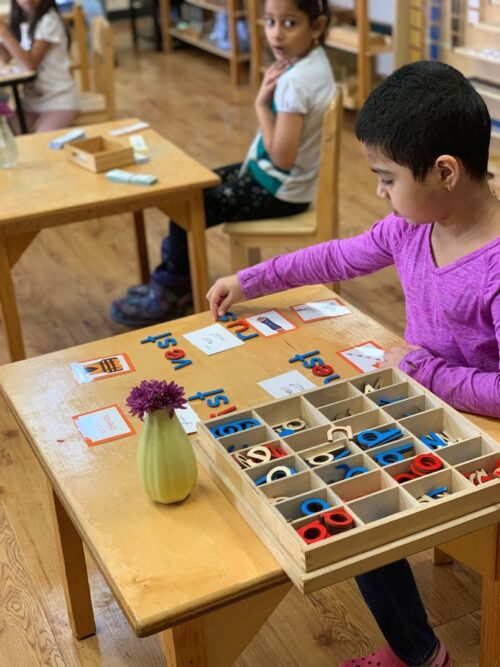
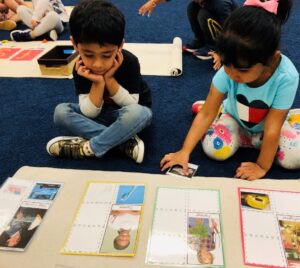
Working together “classifying”
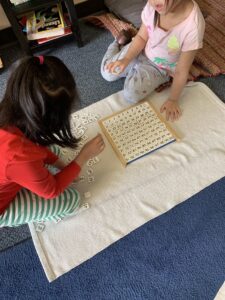
This is the Hundred Board – Some children will spend the entire work cycle with this material
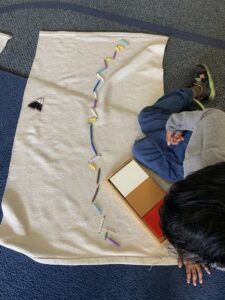
This is the Montessori Snake Game, a fun way for children to begin memorizing facts and boost their adding skills. The goal is to turn a colorful snack into a golden snake by counting to ten.
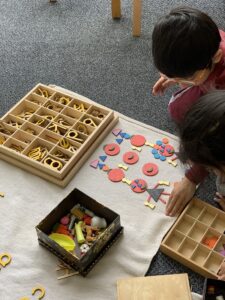
During the 2.5 hour work cycle, most lessons that are given by the guide are to individual children. The children are able to choose their own work and understand that before choosing more challenging work, they might need to wait for a lesson. In the prepared environment, there is plenty of “self-directed” work. This is work that a child may choose and can complete on their own, without a lesson, or a lesson given by an older child in the classroom.
While the classroom guide is giving lessons, they are also observing the entire classroom and noting the self-directed work happening in the classroom. They will note how long a child works with a particular material, if they completed the material or if the material was put away before completion (mastery).
In the Montessori classroom, self-directed work has a beginning, middle and an end. There is a “control of error” which means the work is “self-correcting” – the child knows if the work is completed correctly or not.
For example, the purpose of The Pink Tower is learning the concept of “biggest to smallest”. (Visual discrimination of dimensions.) There are 10 cubes, and each cube is 1cm larger than the next increasing progressively in the algebraic series of the third power.
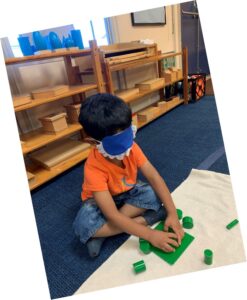
Pranav is next, can he discriminate the size without his eyes?
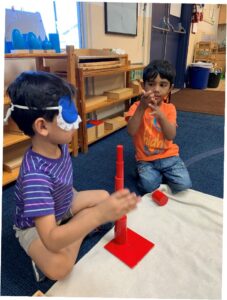
Size Discrimination – with his hands as his eyes
When the child builds the tower, eventually he will see the difference in size.
They may do this over and over again.
Once they have mastered this material, they will likely put it away and never take it out again. They will simply move on. The guide will observe this and understand that the child has mastered the concept.
The child is refining visual motor coordination and develops concentration, refinement of their senses. The child can visually see and understand the discrimination of dimensions.
The Pink Tower is just one example of a material that is found in the prepared environment. Take a look around the Montessori classroom, one will see that hundreds of lessons lie within the materials placed on the shelves. Many of the Montessori materials contain several lessons within one piece of material. Each lesson increases in difficulty. The Montessori teacher guides each child through these lessons.
Think about your workday. If you work in an office, how do you start your day?
It is likely that you will say hello to some work friends, walk around the office a bit, stop by the break room for a snack or a cup of coffee.

Choosing to have snack is an important part of the Montessori Work Cycle
Once you settle in at your desk, you might take care of some lighter tasks, like answering emails or phone calls that are quick. You might read some articles or news, open and read the latest newsletter from MSOSV.
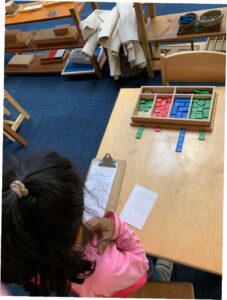
The Stamp Game lesson comes at the end of the Place Value and Decimal System work. The goal is to reinforce the four operations introduced with the Golden Beads but more abstract.
Typically, this might take 15 to 30 minutes.
Now it is time to get to work.
You take a deep dive into your day, the work you will complete that may take a few hours. You have taken yourself to deep concentration.
After completing your work, you might get up and stretch, check in with a friend at work, get a snack, take a quick walk outside.
Does this sound familiar?
If so, this is exactly what your 3–6-year old is up to at school during the 2.5 to 3 hour work period.
The classroom environment is like a second home to the child. With freedom of choice, children move about the classroom:
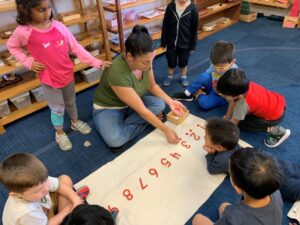
Cards and Counters – this is where odd and even are introduced
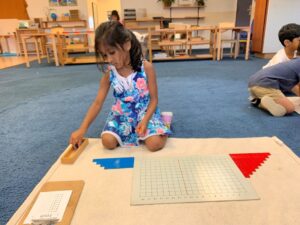
Addition Strip Board reinforces the mathematical concept of adding numeral one through nine – after the bead work. This is more abstract
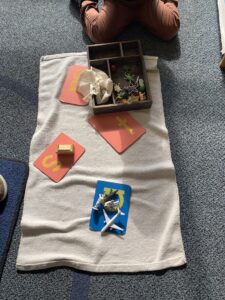
Our younger friends learning the initial sounds. Also here, associating the sound to the letter.
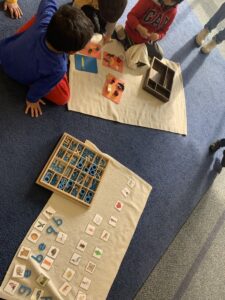
And more…
The deep concentration comes when the children have been at work for 45 minutes to 1 hour. If you were to observe a Montessori classroom at this time, you would notice a lot of movement.
Suddenly, the children are wandering around, mostly without purpose. This is the time when most preschool teachers would ring the bell and have a transition. They might go outside, have a circle time or some other interruption to the work cycle.
Not in the Montessori classroom.
This is called False Fatigue.
“False fatigue is a defining period within a child’s work cycle. Once your child settles into their work, you will observe them with a sense of happiness & satisfaction absorbed in their work. Then, about 45 minutes into the morning work cycle, you may notice the noise level rises and it appears the children begin to lose interest in their work.” (Read more about False Fatigue).
“Phases of the Work Period: Montessori and her directresses carefully observed the phases of children’s work during long work periods. They noted that in the first hour and twenty minutes children often chose an easy initial task, followed by a moderately challenging activity. After this, ten minutes of “false fatigue” occurred as children appeared restless and classroom noise increased. This is the time when many teachers get uneasy and end the work period. However, false fatigue is actually “preparation for the culminating work, ” when children choose challenging work and concentrate deeply. When finished, there is a period of “contemplation” as children appear deeply satisfied and at peace. (ibid)
Children in Montessori classrooms become absorbed in their work because they have the freedom to choose activities that interest them. In classrooms where the work period is less than two hours long, children rarely experience the deep concentration where leaps of cognitive development can take place. Children are understandably hesitant to choose challenging work if they think they won’t have time to complete it (or repeat it 44 times).” (From Montessori Services).
“Montessori teachers who adhere to three –hour work periods without interruption claim one can see the difference in the quality of the children’s concentration on days when children know they will be leaving the classroom in an hour for a doctor’s appointment or a special music class.
Child who expects to be interrupted choose unchallenging and unproductive “busy work”. Any disruption to the child’s work deters critical thinking, problem solving, and exploration which is being developed.”~ Angeline Stoll Lillard, The Science Behind the Genius
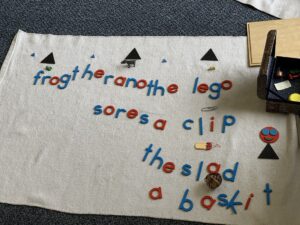
Building sentences using grammar. The big black triangle is the noun.
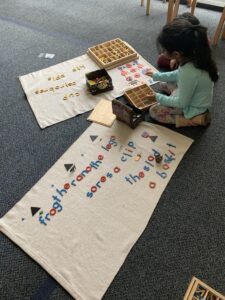
“A child who has become master of his acts through long and repeated exercises, and who has been encouraged by the pleasant and interesting activities in which he has been engaged, is a child filled with health and joy and remarkable for his calmness and discipline.”
~ Dr. Maria Montessori, The Discovery of the Child
“…when the cycle is completed, the child detaches himself from his internal concentration; refreshed and satisfied, he experiences the higher social impulses, such as desiring to make confidences and to hold intimate communion with other souls.”
~ Dr. Maria Montessori, The Advanced Montessori Method
AMI Montessori Resource Library
The Classroom: Not Only Are They Learning, They Have Created a Community